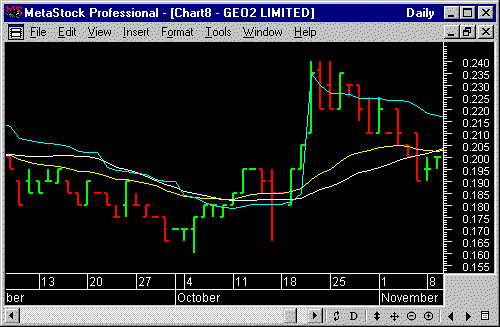|
Moving Averages (all methods)

Description
A moving
average is a method of calculating the
average value of a security's price, or
indicator, over a period of time. The
term "moving" implies, and rightly so,
that the average changes or moves. When
calculating a moving average, a
mathematical analysis of the security's
average value over a predetermined time
period is made. As the security's price
changes over time, its average price
moves up or down.
MetaStock
Pro calculates and displays six
different types of moving averages:
simple (also referred to as arithmetic),
exponential, time series, triangular,
variable, and weighted. In addition,
MetaStock Pro will calculate moving
averages of the security's open, high,
low, close, median price, typical price,
volume, open interest, or indicator.
The only
significant difference between the
various types of moving averages is the
weight assigned to the most recent data.
Once this "weighting" scheme has been
determined, it is held static over the
range of calculations. The exceptions
are the variable moving average and
volume adjusted moving average. The
variable moving average automatically
adjusts its weighting based on market
conditions. A variable moving average
becomes more sensitive to recent data as
volatility increases and less sensitive
to recent data as volatility decreases.
Similarly, the volume adjusted moving
average automatically adjusts as the
security's volume increases and
decreases.
Moving
Average Calculation Methods
Interpretation
The most
popular method of interpreting a moving
average is to compare the relationship
between a moving average of the
security's closing price and the
security's closing price itself. A sell
signal is generated when the security's
price falls below its moving average and
a buy signal is generated when the
security's price rises above its moving
average.
This type
of moving average trading system is not
intended to get you in at the exact
bottom and out at the exact top. Rather,
it is designed to keep you in line with
the security's price trend by buying
shortly after the security's price
bottoms and selling shortly after it
tops.
The
critical element in a moving average is
the number of time periods used in
calculating the average. When using
hindsight, you can always find a moving
average that would have been profitable.
The key is to find a moving average that
will be consistently profitable. The
most popular moving average is the
39-week (or 200-day) moving average.
This moving average has a good track
record in timing the major (long- term)
market cycles. The length of a moving
average should fit the market cycle you
wish to follow:
You can
convert a daily moving average quantity
into a weekly moving average quantity by
dividing the number of days by 5 (e.g.,
a 200-day moving average is almost
identical to a 40-week moving average).
To convert a daily moving average
quantity into a monthly quantity, divide
the number of days by 21 (e.g., a
200-day moving average is very similar
to a 9-month moving average).
MetaStock
Pro enables you to plot moving averages
of securities and any of the indicators
tracked by the program. The
interpretation of an indicator's moving
average is similar to the interpretation
of a security's moving average: when the
indicator rises above its moving
average, it signifies a continued upward
movement by the indicator; when the
indicator falls below its moving
average, it signifies a continued
downward movement by the indicator.
Indicators
which are especially well-suited for use
with moving average penetration systems
include the MACD,
Price R.O.C.,
Momentum, and
Stochastics.
Some
indicators, such as short-term
Stochastics, fluctuate so erratically
that it is difficult to tell what their
trend really is. By removing the
indicator (i.e., setting the Indicator
Style to Invisible in the Indicator's
Properties dialog) and then plotting a
moving average of the indicator, we can
see the general trend of the indicator
rather than its day-to-day fluctuations.
Whipsaws
can be reduced, at the expense of a
slightly later signal, by plotting a
short-term moving average (e.g., 2-10
day) of oscillating indicators such as
the 12-day R.O.C., Stochastics, or the
RSI. For example,
rather than selling when the Stochastic
Oscillator falls below 80, you might
sell only when a 5-period moving average
of the Stochastic Oscillator falls below
80. |